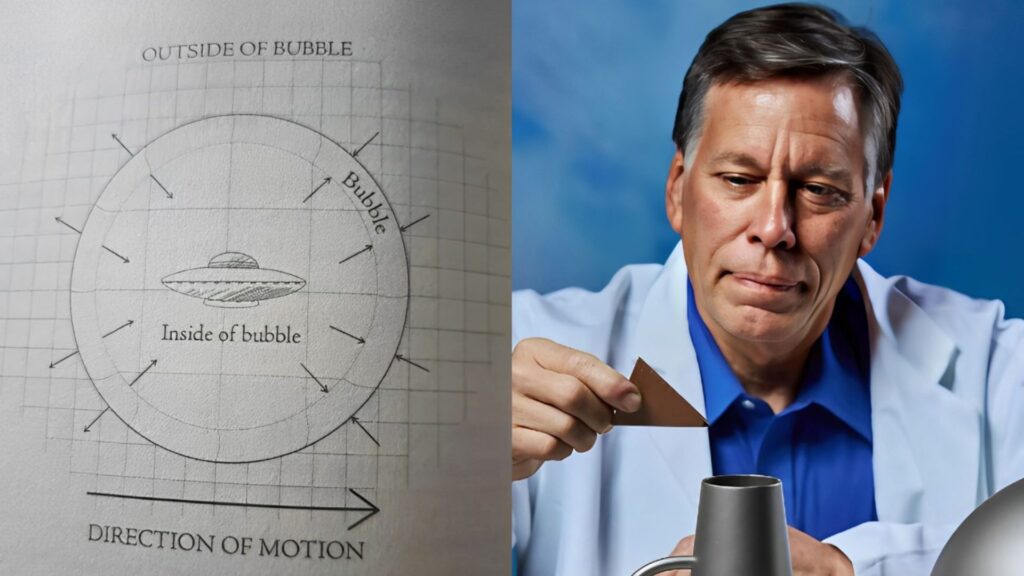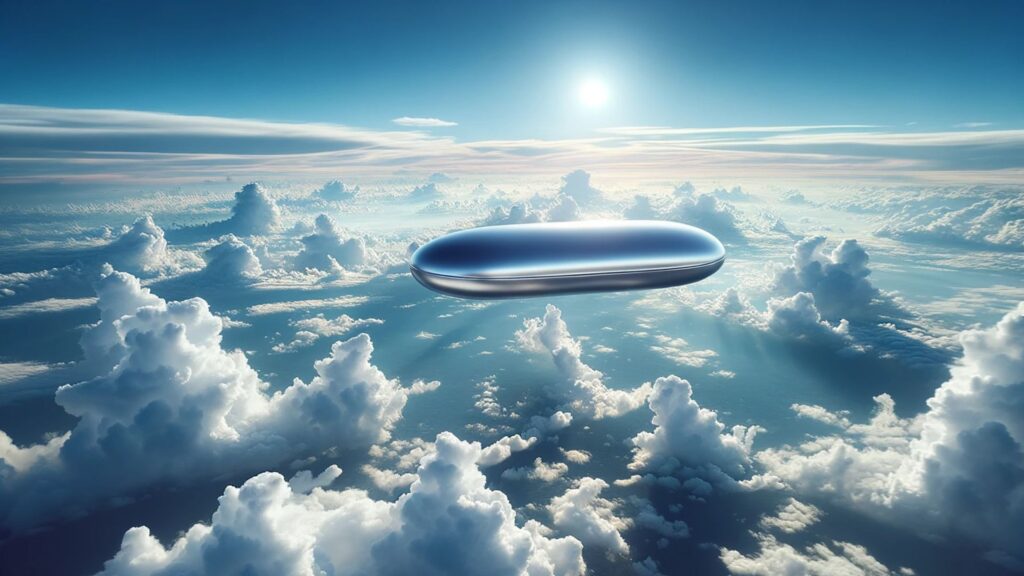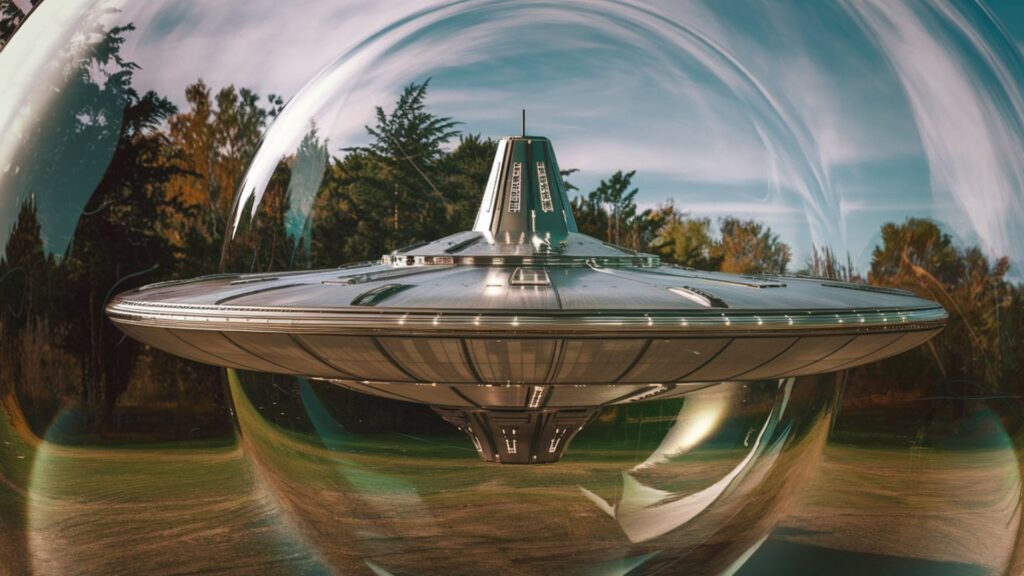In the vast expanse of the cosmos, the question of whether we’re alone has captivated humanity for centuries. As UFO sightings continue to perplex observers worldwide, scientists and researchers are pushing the boundaries of our understanding, seeking explanations that bridge the gap between the seemingly impossible and the scientifically plausible. One such concept that has gained traction in recent years is the Alcubierre Drive – a theoretical propulsion system that could potentially allow for faster-than-light travel. But could this mind-bending technology explain the extraordinary maneuvers reported in UFO encounters? Let’s dig into the science, compare it to other theories, and explore the tantalizing possibilities.
The Alcubierre Drive: Bending Spacetime for Interstellar Travel
Named after Mexican theoretical physicist Miguel Alcubierre, the Alcubierre Drive is a conceptual model that suggests a way to travel faster than light without breaking the laws of physics as we know them. The key idea behind this drive is not to move through space faster than light, but to manipulate spacetime itself.
Here’s how it works in theory:
- The drive creates a bubble of spacetime around a spacecraft.
- It compresses spacetime in front of the bubble and expands it behind.
- This warping of spacetime allows the ship to ride a wave of compressed space, potentially achieving effective faster-than-light travel.
The math checks out – at least on paper. Alcubierre’s equations show that this method of travel doesn’t violate Einstein’s theory of relativity, which states that nothing can move faster than light within spacetime. The Alcubierre Drive sidesteps this limitation by moving spacetime itself.
UFO Sightings and the Alcubierre Drive Connection

Now, let’s consider how this relates to UFO sightings. Many eyewitness accounts describe objects performing maneuvers that seem to defy our current understanding of physics:
- Instant acceleration to hypersonic speeds
- Abrupt stops and direction changes without inertial effects
- Seamless transitions between air and water
These characteristics align eerily well with what we might expect from a craft utilizing an Alcubierre Drive. The compression and expansion of spacetime could explain the apparent lack of inertia and the ability to achieve extreme speeds without causing harm to potential occupants.
Dr. Harold “Hal” Puthoff, a physicist and former contractor for the U.S. government’s secretive UFO program, has suggested that some reported UFO behaviors could be consistent with the manipulation of spacetime metrics. In a 2018 presentation, he stated, “We’re beginning to understand that it’s possible to modify spacetime, theoretically, in ways that allow you to go places and do things that we previously thought were only in the realm of science fiction.”
Bob Lazar’s Warp Bubbles: A Parallel Concept?

The idea of manipulating spacetime for propulsion isn’t unique to the Alcubierre Drive. Bob Lazar, a controversial figure in ufology, claimed in 1989 to have worked on reverse-engineering alien spacecraft at a secret facility called S-4 near Area 51. Lazar described a propulsion system that bears striking similarities to the Alcubierre concept, despite predating Alcubierre’s 1994 paper by several years.
Lazar’s “warp bubbles” theory posits that alien craft use element 115 (which hadn’t been synthesized at the time of his claims) to generate a gravity wave. This wave would then be used to compress spacetime in front of the craft and expand it behind, much like the Alcubierre Drive.
Key points of comparison:
- Both theories involve the manipulation of spacetime geometry.
- Both suggest the creation of a “bubble” around the craft.
- Both aim to achieve effective faster-than-light travel without technically exceeding light speed.
While Lazar’s claims remain unverified and highly controversial, the parallels to later scientific proposals are intriguing. It’s worth noting that element 115, now known as moscovium, was officially recognized in 2015. However, its observed properties don’t match Lazar’s descriptions, and it’s extremely unstable, with a half-life of less than a second.
As an Amazon Associate, I earn from qualifying purchases that help keep this content free.
Luis Elizondo’s “Imminent” and the Five Observables

Luis Elizondo, former director of the Advanced Aerospace Threat Identification Program (AATIP), has become a prominent voice in the UFO disclosure movement. In his book “Imminent,” Elizondo discusses what he calls the “five observables” – characteristics of UFOs that set them apart from known human technology:
- Anti-gravity lift
- Sudden and instantaneous acceleration
- Hypersonic velocities without signatures
- Low observability or cloaking
- Trans-medium travel
These observables, particularly the first three, align closely with the theoretical capabilities of an Alcubierre Drive. Elizondo writes, “The technology we’re observing suggests a mastery of the fundamental forces of the universe – gravity, electromagnetism, and perhaps even spacetime itself.”
Elizondo’s work has brought renewed scientific attention to the UFO phenomenon. He argues that these unexplained craft, if indeed utilizing something akin to an Alcubierre Drive, could revolutionize our understanding of physics and propulsion technology.
The Energy Requirements: A Galactic-Scale Problem?
While the Alcubierre Drive offers an enticing explanation for UFO behavior, it faces a significant hurdle: energy requirements. Initial calculations suggested that the drive would need negative energy density equal to the mass-energy of the entire visible universe.
However, subsequent research has offered more optimistic figures:
- In 2012, NASA physicist Harold White proposed design modifications that could reduce the energy needs to the mass-energy equivalent of the Voyager 1 spacecraft (about 700 kg).
- A 2021 study by researchers at Applied Physics suggested that a warp bubble could be created with positive energy, potentially making the concept more feasible.
Despite these advancements, the energy demands remain far beyond our current technological capabilities. This leads to an interesting question: If UFOs are indeed utilizing Alcubierre-like drives, what energy source could power them?
Dr. Eric W. Davis, an astrophysicist who consulted for the Pentagon’s UFO program, has suggested that advanced civilizations might harness zero-point energy – the lowest possible energy that a quantum mechanical system may have. This concept, while still theoretical, could provide the immense power needed for faster-than-light travel.
Observational Evidence: The Nimitz Encounter

One of the most compelling UFO incidents in recent history, the 2004 Nimitz encounter, provides tantalizing hints that align with Alcubierre Drive predictions. During this event, Navy pilots observed an object, dubbed the “Tic Tac” due to its shape, performing seemingly impossible aerial maneuvers.
Commander David Fravor, one of the pilots involved, described the object’s behavior:
- It dropped from 80,000 feet to sea level in less than a second.
- It demonstrated instantaneous acceleration and deceleration.
- It showed no visible means of propulsion or flight surfaces.
These observations match what we might expect from a craft utilizing an Alcubierre Drive. The apparent lack of inertial effects and the ability to achieve extreme accelerations without visible propulsion systems are consistent with the manipulation of spacetime rather than conventional propulsion methods.
The Implications for Physics and Technology
If UFOs are indeed powered by something akin to an Alcubierre Drive, the implications for our understanding of physics and technology are profound. Some potential areas of impact include:
- Energy Production: The ability to harness the enormous energies required for such a drive could solve Earth’s energy crisis.
- Space Exploration: Faster-than-light travel would open up the galaxy for exploration and potential colonization.
- Fundamental Physics: Confirmation of such technology would bridge the gap between quantum mechanics and general relativity, potentially leading to a unified theory of physics.
- Materials Science: The materials needed to withstand the stresses of warping spacetime would revolutionize numerous fields.
Dr. Michio Kaku, a renowned theoretical physicist, has stated, “If UFOs are real and do employ some form of faster-than-light travel, it would force us to rewrite our physics textbooks. It would open up new avenues of research that could advance our civilization by centuries.”
Challenges and Skepticism
Despite the exciting possibilities, many scientists remain skeptical about both the feasibility of the Alcubierre Drive and its connection to UFO phenomena. Some key challenges include:
- Causality Violations: Faster-than-light travel could potentially allow for time travel, creating paradoxes.
- Hawking Radiation: Stephen Hawking theorized that the event horizon of an Alcubierre bubble might produce intense radiation, potentially destroying anything inside.
- Lack of Concrete Evidence: While UFO sightings are numerous, we still lack definitive, scientifically verifiable evidence of extraterrestrial technology.
Dr. Sean Carroll, a theoretical physicist at Caltech, cautions, “While the math of the Alcubierre Drive is interesting, we have no evidence that the required negative energy density can exist in the real world. We should be careful about using speculative physics to explain unexplained phenomena.”
The Road Ahead: Research and Possibilities

As our understanding of physics evolves and our observational capabilities improve, we may edge closer to unraveling the mysteries of UFOs and the potential for faster-than-light travel. Current and future research initiatives offer hope for progress:
- The Galileo Project: Led by Harvard astronomer Avi Loeb, this project aims to systematically search for evidence of extraterrestrial technological artifacts near Earth.
- DARPA’s Hypersonic Research: While not directly related to Alcubierre Drives, advances in hypersonic technology could provide insights into extreme propulsion methods.
- Quantum Gravity Research: Efforts to reconcile quantum mechanics and general relativity could lead to breakthroughs in our understanding of spacetime manipulation.
Conclusion: A Universe of Possibilities
The concept of UFOs powered by Alcubierre Drives remains in the realm of speculation, bridging the gap between eyewitness accounts and cutting-edge theoretical physics. While we lack concrete proof, the alignment between reported UFO behaviors and the theoretical capabilities of faster-than-light travel technologies is thought-provoking.
As we continue to push the boundaries of science and explore the cosmos, we must remain open to possibilities that challenge our current understanding. Whether or not UFOs turn out to be extraterrestrial craft utilizing advanced propulsion systems, the pursuit of this knowledge drives us to explore new frontiers in physics, engineering, and our place in the universe.
The truth, as they say, is out there. With continued scientific inquiry, open-minded research, and rigorous investigation, we may one day bridge the gap between speculation and discovery, revealing the extraordinary technologies that could reshape our understanding of the cosmos and our place within it.
